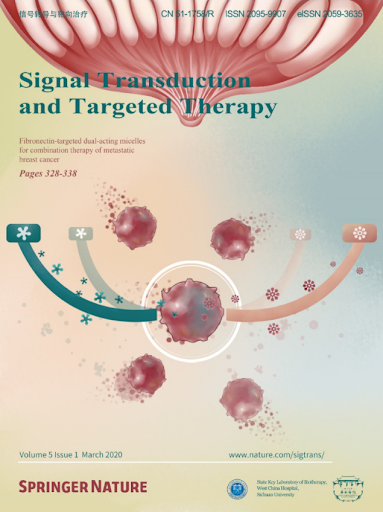凝析纳米疫苗佐剂通过mtDNA泄漏触发的cGAS-STING轴激活增强CD8+ t细胞依赖性抗肿瘤免疫。
IF 52.7
1区 医学
Q1 BIOCHEMISTRY & MOLECULAR BIOLOGY
引用次数: 0
摘要
目前临床疫苗佐剂的种类和功能仍然有限。传统的铝基佐剂主要诱导th2偏向的体液免疫,但诱导th1介导的细胞免疫反应的能力有限,特别是肿瘤抗原特异性细胞毒性CD8+ T淋巴细胞(ctl),这是有效的癌症疫苗性能所必需的。受天然生物分子凝聚物的启发,我们开发了一种通用的非共价蛋白自组装策略,不同于需要结构域修饰或双功能交联剂的传统方法。我们的方法采用两亲性分子(肉豆酸钠/SMA和十二烷基硫酸钠/SDT)作为分子桥,通过疏水力和二硫键形成介导蛋白质-蛋白质相互作用。这一过程产生的纳米级蛋白质凝析液(PCD)疫苗具有优异的稳定性。作为一种新型的佐剂体系,这些合成凝聚体通过优化关键参数:抗原负载能力、淋巴结靶向、细胞质递送和溶酶体逃逸,显著增强抗原交叉递呈。因此,它们诱导强大的抗原特异性CTL反应和体液免疫,显示出强大的抗肿瘤功效。重要的是,我们发现合成蛋白凝聚物(PCD)单独可以作为纳米佐剂。PCD通过增加线粒体膜通透性,诱导线粒体DNA渗漏到细胞质中,激活cGAS-STING通路,促进DC成熟。这种安全且可扩展的平台消除了复杂的共价修饰或基因工程的需要,并且它促进了多种模块化抗原的设计,包括新抗原和病毒抗原。该合成的PCD疫苗佐剂制备工艺简单,具有良好的免疫原性,具有重要的临床应用和转化潜力。本文章由计算机程序翻译,如有差异,请以英文原文为准。
Condensate nanovaccine adjuvants augment CD8+ T-Cell-dependent antitumor immunity through mtDNA leakage-triggered cGAS-STING axis activation.
The variety and functionality of current clinical vaccine adjuvants remain limited. Conventional aluminum-based adjuvants predominantly induce Th2-biased humoral immunity but exhibit a limited capacity to elicit Th1-mediated cellular immune responses, particularly tumor antigen-specific cytotoxic CD8+ T lymphocytes (CTLs), which are essential for effective cancer vaccine performance. Inspired by natural biomolecular condensates, we developed a versatile noncovalent protein self-assembly strategy distinct from traditional approaches requiring structural domain modifications or bifunctional crosslinkers. Our methodology employs amphiphilic molecules (sodium myristate/SMA and sodium dodecyl thiolate/SDT) as molecular bridges to mediate protein‒protein interactions through hydrophobic forces and disulfide bond formation. This process generates nanoscale protein condensate (PCD) vaccines with exceptional stability. As a novel adjuvant system, these synthetic condensates significantly enhance antigen cross-presentation by optimizing key parameters: antigen loading capacity, lymph node targeting, cytosolic delivery, and lysosomal escape. Consequently, they induce robust antigen-specific CTL responses and humoral immunity, demonstrating potent antitumor efficacy. Importantly, we found that the synthetic protein condensate (PCD) alone can act as a nanoadjuvant. By increasing mitochondrial membrane permeability, PCD induces mitochondrial DNA leakage into the cytosol, activating the cGAS‒STING pathway and promoting DC maturation. This safe and scalable platform eliminates the need for complex covalent modifications or genetic engineering, and it facilitates the design of diverse modular antigens, including neoantigens and viral antigens. Given its straightforward manufacturing process and superior immunogenicity, this synthetic PCD vaccine adjuvant has significant potential for clinical application and translation.
求助全文
通过发布文献求助,成功后即可免费获取论文全文。
去求助
来源期刊

Signal Transduction and Targeted Therapy
Biochemistry, Genetics and Molecular Biology-Genetics
CiteScore
44.50
自引率
1.50%
发文量
384
审稿时长
5 weeks
期刊介绍:
Signal Transduction and Targeted Therapy is an open access journal that focuses on timely publication of cutting-edge discoveries and advancements in basic science and clinical research related to signal transduction and targeted therapy.
Scope: The journal covers research on major human diseases, including, but not limited to:
Cancer,Cardiovascular diseases,Autoimmune diseases,Nervous system diseases.
 求助内容:
求助内容: 应助结果提醒方式:
应助结果提醒方式:


